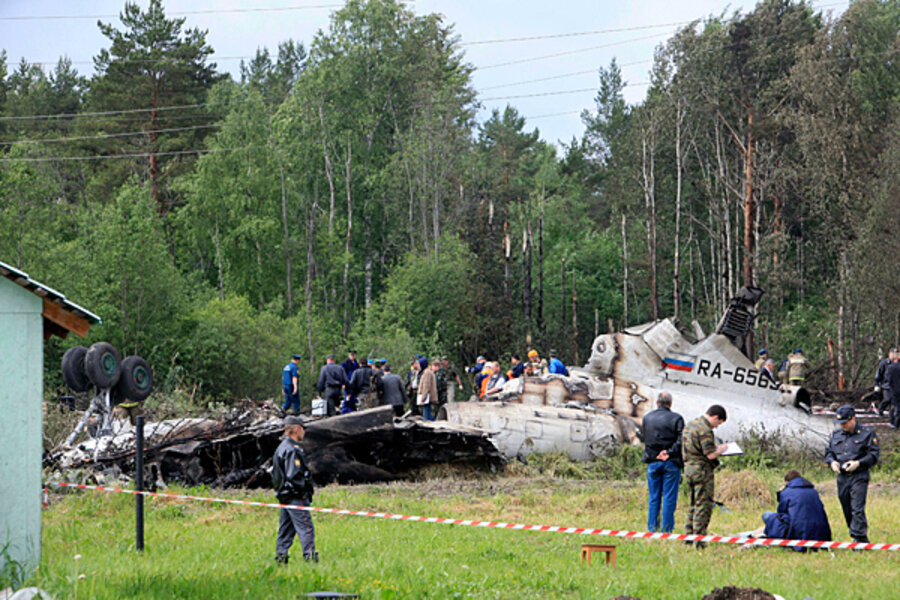Russian plane crash highlights concern about Soviet-era jets
Loading...
| Moscow
A fatal plane crash in western Russia has once again focused attention on the country's fleet of Soviet-built Tupolev jets, which do not meet international standards but are still flown by many regional airlines.
Russian aviation officials blamed pilot error for the accident, which killed 44 people – including eight foreigners.
The Tu-134 and its big sister, the Tu-154, were the main workhorses of Soviet aviation, which used to transport about 120 million passengers annually; twice Russia's current traffic. The country's main carrier, Aeroflot, retired all its Tupolev planes in 2009, but about 230 of each type remain in use with smaller airlines serving far-flung Russian communities and airlines of former Soviet republics.
Though notoriously cramped and uncomfortable, the planes until recently enjoyed safety records comparable to many similar Western-built aircraft. According to SOAR, a private company that teaches clients to overcome the fear of flying, both the Tu-134 and the Tu-154 have suffered about one crash per million hours of flying, or roughly the same rate as the Douglas DC-9 and Airbus 310.
But a series of accidents with Tupolevs in recent years has raised questions about whether the planes are getting too old to continue service in Russia, where foul weather is the default condition, airports are run down, and equipment is often substandard.
Russian official promotes Tu-134 replacement at Paris Air Show
In today's incident, a 30-year-old Tupolev Tu-134 flown by the RusAir regional airline with 52 people aboard reportedly clipped a tree and then crashed onto a highway while attempting to land in poor weather at Petrozavodsk airport in Karelia, a Russian republic that borders Finland.
"From the initial external data, the pilot's mistake is clear. In bad weather conditions he veered to the right of the runway and in foggy conditions searched for the runway visually until the last minute [and] did not find it," deputy prime minister Sergei Ivanov told journalists.
Mr. Ivanov, who oversees Russian aviation, was in France on Tuesday along with Prime Minister Vladimir Putin to attend the Paris Air Show and promote Russian aerospace technology – in particular the new Sukhoi Superjet 100, which is designed to replace the Tu-134 on Russia's myriad short-haul routes.
Russia's safety record improving
A year ago, in a strikingly similar accident to Monday's disaster, a Tu-154 belonging to the Polish Air Force crashed in Smolensk, Russia, with almost 100 people on board, including Poland's president. A Russian investigation concluded that bad weather and pilot error led the plane to miss the runway and careen into a nearby forest.
The biggest recent spate of accidents with Tupolev jets has occurred in Iran, leading some experts to speculate that local factors, such as international sanctions that prevent importation of aviation equipment, could be responsible.
Russia had one of the world's worst air-safety records as recently as five years ago. But the International Air Transport Association (IATA) said in a statement this week that Russia has been making progress in improving air safety, though it still has some distance to go.
None of Russia's 13 major carriers has suffered a fatal accident in the last three years, the statement quoted IATA's general director, Giovanni Bisignani, as saying. "But safety concerns remain with the continued operation of some Russian-built equipment that does not comply with International Civil Aviation Organization standards," he added.
Planes' age not the main problem
Some Russian aviation experts insist that the age of the Tu-134 (which entered service in 1967) and the Tu-154 (since 1970) makes little difference. They place the blame for the post-Soviet uptick in accidents on other factors, including corner-cutting on maintenance by small airlines, inadequate pilot training, and deteriorating airport services.
"The main thing is not the age, but the technical state of a plane," says Alexei Sinitsky, editor of Aviatransportnoye Obozreniye, a leading Russian aviation journal.
"Older planes don't get equipped with any new expensive systems, because that is not profitable," he says, which would explain why Russia's aging fleet of Tupolevs fall short of the latest international standards.
"They may be old, but that's no reason to write them off," he says.





